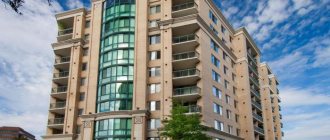Primary housing market
Many people believe that primary housing is any apartment in a new building, but this is not entirely true. The primary and secondary housing markets differ not at all in the newness of the apartments, but in one important legal detail of the transactions. Only housing purchased directly from the developer is considered primary, and not all apartments are sold this way. Often, immediately after putting an object into operation, the developer company transfers ownership of the apartment to persons affiliated with it, who subsequently sell them. Such transactions take place on the secondary market, since ownership passes from the first owner to the second, although the housing itself is completely new.
Risks when buying a secondary home
One of the main risks is purchasing an apartment under a secondary power of attorney. Everyone knows that there are black realtors on the market. Choosing weak and irresponsible citizens as their victims, they re-register documents as dummies and sell the apartment. The first sign of such an offer will be a reduced price of housing, as scammers are in a hurry to complete the deal. You should also beware of tracking by proxy, as serious problems can arise with this.
To sell an apartment, the consent of all its owners is required. If the owners have minor children, then the consent of the guardianship and trusteeship authorities is required. If someone claims their rights after the transaction has been completed, it will be declared invalid. It is necessary to trace the entire history of the apartment, how many times it was sold, how it got to the owner. The transaction will be invalid if one of the relatives about whom it was not known declares their rights to the inheritance.
There are many features of selling an object if this apartment is a “resale” apartment. What does it mean? You need to carefully check all the information, understand the situation in the housing market and think through all the possible issues that will bother you in the future.
If you find an error, please select a piece of text and press Ctrl+Enter.
Pros of primary
- Price
When comparing what is more expensive - primary or secondary, people choose new buildings precisely because of the price. The greatest benefit goes to those who made a purchase at the stage of the so-called foundation pit, because the cost of the housing being built at the start of sales is minimal.
- Wide range of choices
There are a lot of offers from developers. The buyer has the opportunity not only to choose the area, but also a specific floor, layout and even view characteristics. Also, some developers make apartments with finished finishing.
- New engineering communications and modern engineering solutions.
When you move into a new building, you can be almost sure that in the next 5-10 years you will not have to think about clogged sewers or electrical wiring that cannot withstand the load.
- Infrastructure
Most modern residential complexes are built together with vital facilities: public spaces, schools, kindergartens, convenience stores.
- Minimal risks
If you buy an apartment using a DDU, the law is on your side, all risks are insured and there is nothing to worry about.
Buying an apartment: what to choose?
Having understood what the concepts of “new building” and “resale” mean, you can decide on purchasing an apartment. When choosing the type of real estate - secondary or primary - a number of parameters are compared, according to which the decision is made.
- Price issue. Primary housing usually costs less than secondary housing of similar size and area. The price per square meter in a house under construction varies depending on the stage of its completion, increasing towards the end of construction. In the same area with a new building with the same indicators, the “resale” will cost more.
- Deadlines. It is worth considering that the lucky owner of a new building under the DDU can move in within a year or a year and a half if the contract was drawn up at the excavation stage, or within 3 months if the apartment is purchased before putting it into operation. Moreover, construction may drag on indefinitely. You can move into secondary housing immediately after the transaction is concluded.
- Repair and finishing. Often a new building is purchased at the stage of rough finishing - “concrete walls”, then the cost of finishing will be much higher than even a major renovation of a secondary market apartment. But you can design the interior space yourself. Given the same conditions of the housing, less money will be spent on a new building: no dismantling will be required, all new communications will be installed. If you buy a secondary home after renovation, you can do without additional investments.
- Paperwork and risks. The procedure is more transparent when purchasing a new building, the apartment is “legally clean”. Fraud schemes are common when purchasing secondary homes. Legal literacy or the help of a lawyer will help avoid this problem.
- Apartment on credit. Not all banks are engaged in lending to primary real estate. In this regard, buying a secondary home is more profitable.
- Comfort. For many, the effect of a new apartment and the feeling of being the “first” owner are important components. Infrastructure can be developed in both new and old areas, but modern communications in a new building are important.
All categories of housing have disadvantages and advantages - both new buildings and secondary housing. When choosing an apartment to buy, each person himself determines the criteria that are decisive for him.
Read more about choosing between a new building and a secondary home to buy...
Cons of primary
- Delayed acquisition of ownership
Until the delivery of the object, you do not own anything except the so-called right of claim.
- Waiting for occupancy and lack of finishing
Not everyone is pleased to part with a large sum of money, wait for the property to be delivered, and even receive an apartment with bare walls.
- Rotary hammer noise for the first few years
This is a given that nothing can be done about. Your neighbors will not do the renovations at the same time, and those who are particularly leisurely can stretch out the pleasure for several years.
- Lottery with neighbors
Unfortunately, there is no way to find out who will live on the same site with you, and there is always a risk of bumping into very “noisy” people. This can greatly affect your comfort level.
- Temporary absence of roads, local area and construction waste
All this can also be a reason to refuse an apartment in a new building.
As we found out above, secondary housing is any property purchased with the transfer of ownership from one owner to another. To understand what is better, primary or secondary housing specifically for you, we will reveal the features of the second type of housing.
What types of apartments are there on the secondary market?
Secondary housing is a wide selection of apartments of various categories and characteristics. Real estate specialists identify several types of real estate in this market, classified by physical characteristics and cost level:
- Low-quality housing - apartments in old buildings, 2-3 floors high. In such premises there are often no basic communications - sewerage and water supply. Homes are often heated using stove heating.
- Standard premises - ordinary secondary housing, one-room or two-room apartments in standard buildings with a height of 5-16 floors.
- Improved apartments are housing in modern and standard buildings, characterized by increased comfort. Characteristically, there are utility rooms such as pantries and dressing rooms, as well as a larger number of bathrooms than in ordinary premises.
- Luxury housing is class A real estate, the peculiarity of which is the presence of a landscaped local area, parking, concierge and security guards. Elite buildings, as a rule, have no more than 30 apartments.
Advantages of resale
- Ready infrastructure
Apartments on the secondary market, as a rule, are located in populated areas in which the surrounding infrastructure has already been developed: kindergartens and schools, shops, pharmacies, etc. This also happens on the primary market, but in smaller volumes.
- Ready-to-move-in housing
In most cases, you buy a lived-in apartment, which you can move into immediately after the transaction is completed. Savings on repairs can amount to more than a million rubles.
- Opportunity to meet neighbors before purchasing
If this point worries you greatly, you can always find out who is around you and make a decision about the transaction based on this.
- Possibility to negotiate price
Most sellers artificially inflate the cost of housing so that there is an opportunity for dialogue and bargaining. Be sure to take advantage of this opportunity.
Bank requirements for the secondary market
But credit institutions also have their own requirements for an apartment that has been owned. After all, real estate becomes bank collateral for the entire loan period. If the borrower turns out to be financially insolvent, the bank will be obliged to sell the collateral so as not to incur losses. Therefore, the apartment must meet certain physical characteristics so that nothing interferes with its subsequent resale.
- The house in which the borrower plans to purchase housing must be built no earlier than 1957.
- A prerequisite is the presence of all modern communications. The bank will not take as collateral a house that does not have hot and cold water supply, heating and sewerage.
- By the time the mortgage is paid in full, the house in which the apartment is located should not be physically worn out by more than 70%.
Cons of resale
- Legal risks
It is on the secondary market that a lot of transactions happen that are subsequently challenged in court. Only experienced lawyers can protect the transaction from risks, who, before purchasing, will check the apartment for encumbrances, as well as its legal cleanliness.
- Depreciation of housing stock and hidden defects
Faulty sewerage, overloaded electrical wiring, dirty entrance, leaking roof or freezing walls - all this can greatly spoil the joy of a long-awaited purchase.
- Unauthorized redevelopment
When buying a home with an improved layout, made by the old owner “for himself,” remember, this must have permission from all regulatory authorities.
Selecting an area
Each person has their own priorities when choosing a profitable area to live. Some choose a location with good transport links, closer to work or the center, where the area is young and elite.
Families tend to live in areas with infrastructure, where hospitals, schools, and kindergartens are within walking distance. Pensioners are better off where it is calm and green. Fresh air prevails to provide a peaceful break from the noise and bustle of the city.
Ecology plays a significant role. It’s good if there is a square or green park next to the house. The downside is that if there are smoke-filled enterprises nearby, there are high-voltage lines that are harmful to health.
If you have a personal car, parking near the house is advisable. Of course, it’s good for older people to have pharmacies, clinics, and consumer services nearby.
Video on how to choose a secondary apartment:
Conclusion
There is no clear answer to the question of what is more profitable, primary or secondary. It all depends on the needs of a particular buyer. An apartment in a new building is more suitable for those who have the opportunity to plan their move-in more than six months in advance and are not ready to put up with the disadvantages of the secondary market. Well, if the issue of moving is urgent, it makes sense to consider secondary housing. This must be done as responsibly as possible in order to eliminate the numerous risks that we talked about. The best option is to turn to real estate professionals. Enjoy the shopping!
Have questions?
Leave your phone number and we will contact you within 15 minutes!
Get a free consultation
Where can I buy?
The need to buy housing is especially acute in large cities and capitals, where it is very difficult to find good and inexpensive apartments. Secondary housing (Moscow, St. Petersburg) is sometimes the only way to choose the best option for yourself. Of course, to find a suitable apartment in these cities, you will have to look through a lot of advertisements and meet with many owners. Particular attention should be paid to the legal side of the planned transaction. Fraud with apartments in capitals is much more common than in small towns.
Where to look for offers? Internet resources will become a convenient method of searching for an apartment. Secondary housing on Avito offers a large number of options that can be selected using an advanced search, including cost, area, living area, number of floors of the building, number of rooms and other indicators. Of course, the best acquisition method would be to seek the services of realtors from trusted companies. Professionals will not only independently select the most worthy options for viewing, but will also help in checking documents and drawing up a purchase and sale agreement.
Secondary housing does not lose its relevance over the years. It's easier for people to buy something that they can see with their own eyes. The speed of the transaction also plays a role: processing within a few weeks adds confidence that the money will not be wasted.









